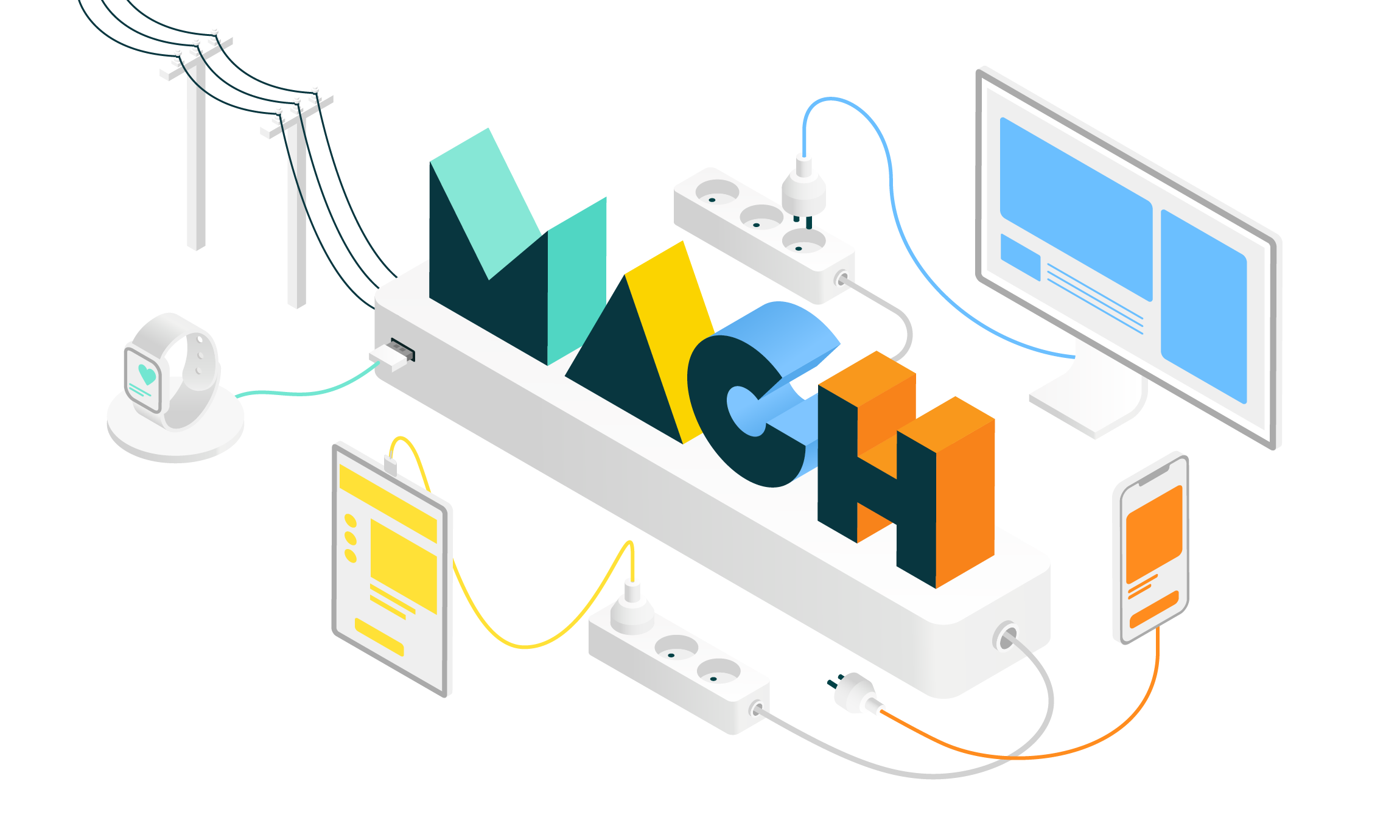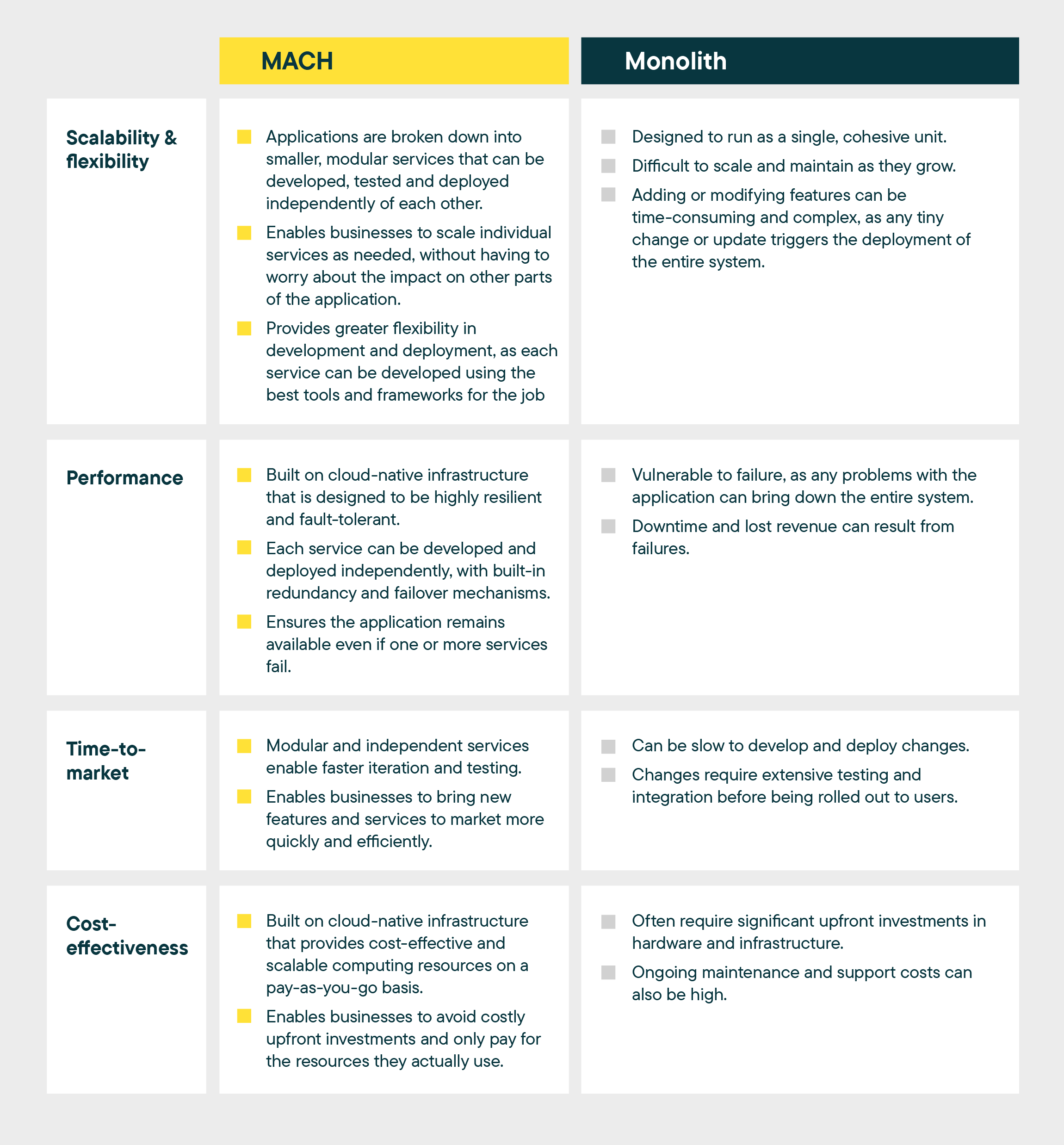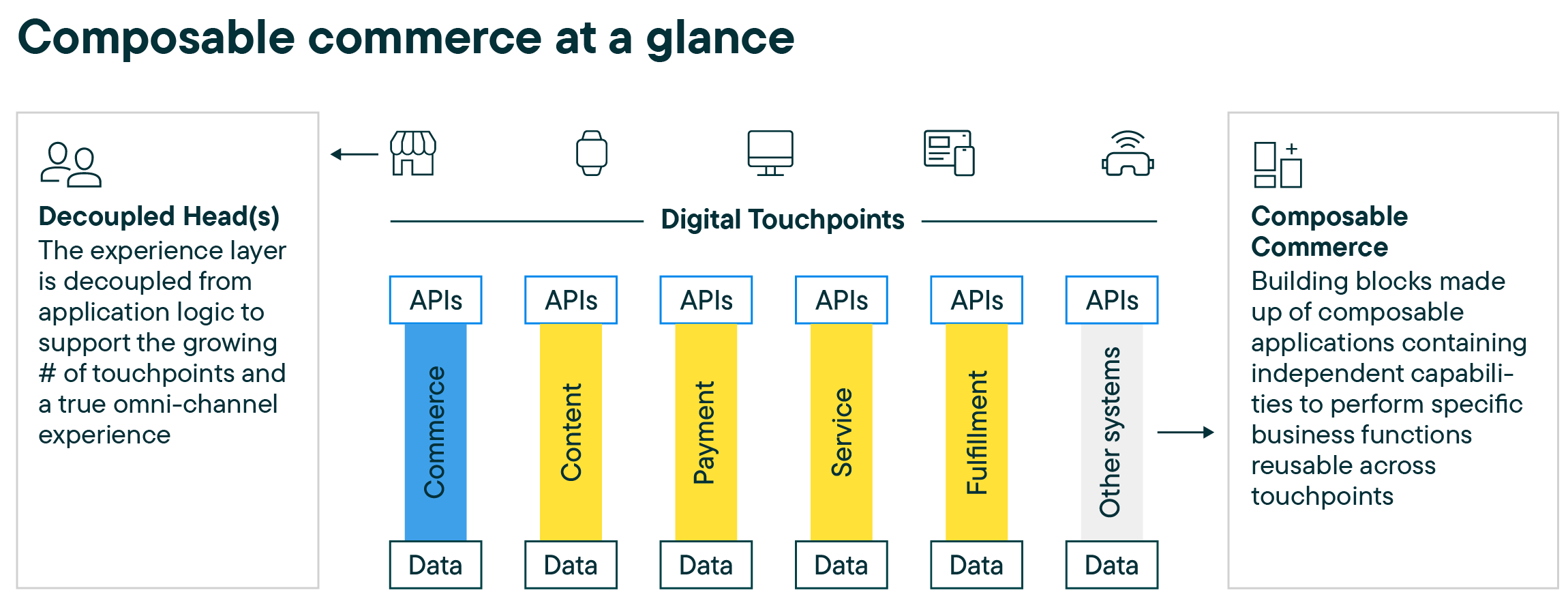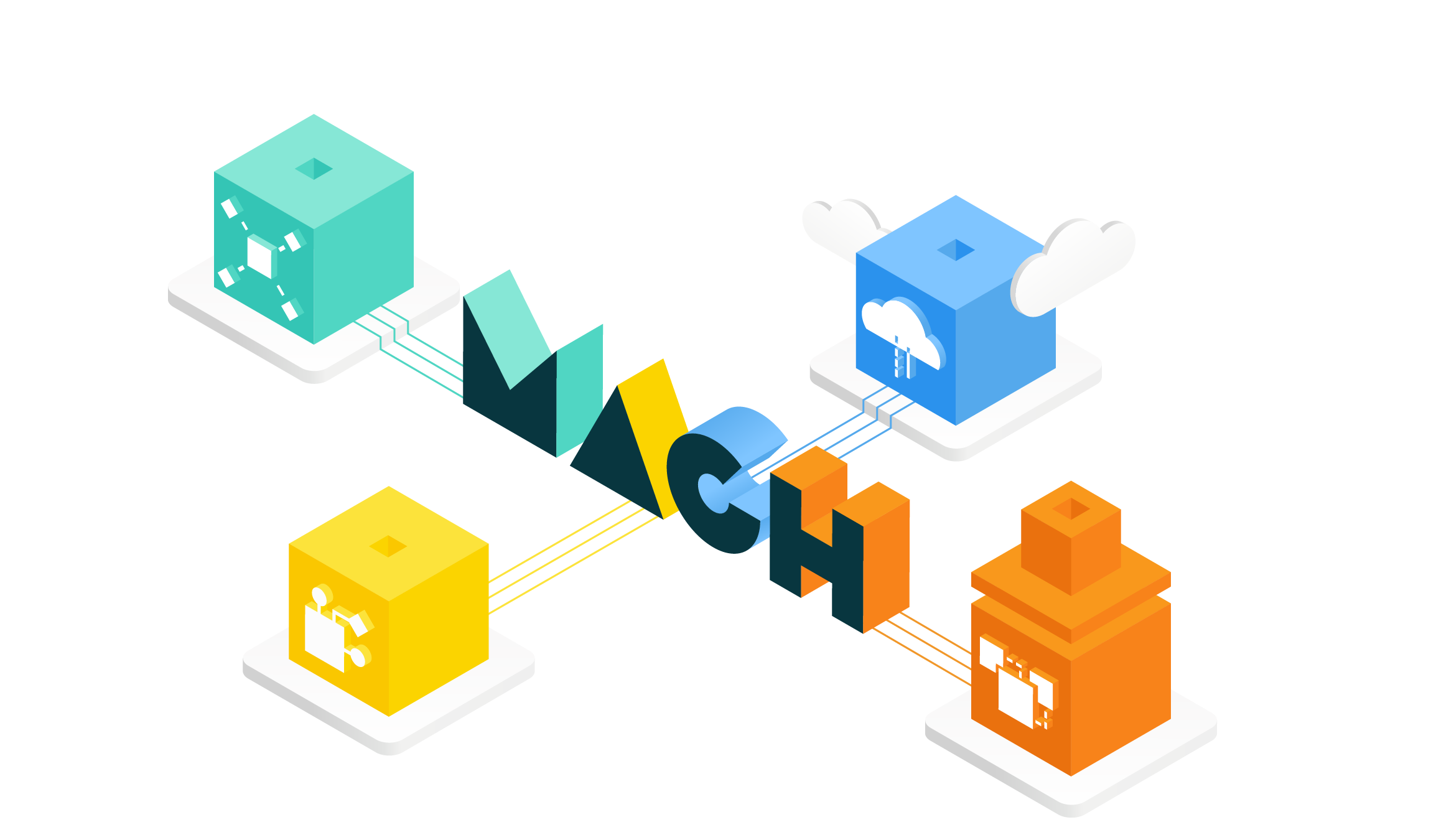
MACH seems to be the hottest buzzword in the commerce world right now — and for good reason. Introduced by commercetools, the word "MACH" has spread like wildfire throughout the digital world, espoused by IT gurus, tech experts and eCommerce moguls as the thing you need to have because it makes everything about digital commerce better. But what exactly is MACH architecture? How does it compare to monolithic platforms? And where does composable commerce fit into all of this? If these questions are at the top of your list, then buckle up for the answers — because we're here to get you up to speed on all things MACH.

What is MACH architecture?
Not to toot our own horn, but we at commercetools have revolutionized eCommerce. Not only are we the inventor of headless commerce, but we're also the ones behind MACH architecture, which was born from commercetools founder Dirk Hoerig. He saw major enterprises struggling to keep up — and felt traditional commerce platforms, with their rigid structure, were holding them back. So, he and the team at commercetools developed our MACH approach to deliver open, modular and scalable eCommerce systems that allow for agile development. And now our MACH architecture has taken off across industries all over the digital world.
In fact, according to research conducted by the MACH Alliance, a not-for-profit organization that advocates open and best-of-breed technology ecosystems, 85% of organizations have increased the amount of MACH technology in their digital commerce infrastructures in the past 12 months. So, what exactly is MACH and why does it matter? To begin with, the technologies that MACH architecture utilizes include:
API-first: The API-first approach is widely adopted in modern digital applications and is how brands add best-of-breed components and combine them into a custom application built for specific business needs. Essentially, this is how commercetools delivers composable commerce: You can select any of the +300 commerce APIs available for promotions, product information management system, orders and checkout and plug them in.
Cloud-nativity: Being cloud-native in MACH architecture means leveraging cloud-based infrastructure and services, resulting in significant cost advantages by avoiding the high costs of maintaining on-premise infrastructure, such as hosting, site acceleration, security and uptime. Cloud-native commerce also operates on a pay-as-you-go model, reducing overall hosting and provisioning costs. This makes it a cost-effective solution for businesses of all sizes, while offering flexibility to scale their digital commerce infrastructure quickly and efficiently.
Headless: Headless commerce enables brands to unlock the freedom to create stunning shopping experiences. This is possible by decoupling the storefront (frontend) from the commerce engine (backend). The frontend can be a webshop, social media, mobile apps and even the Internet of Things (IoT). The backend is the layer where all the systems, processes and tools run to handle commerce operations, including product information management, checkout and more.
Microservices: Microservices bring together loosely coupled, independently deployable small components or "services" to compose a more integrated application. Using microservices, these applications deliver faster responses, are more reliable, and can be deployed more frequently. Microservices are exposed via well-defined APIs as the communication method between frontends and backends.
Multi-tenant: A software architecture where a single instance of the software is shared by multiple customers, each with their own isolated data and configuration. Multi-tenancy is often used in SaaS applications to provide cost-effective and scalable software services to a large number of customers. The MACH approach is well-suited for multi-tenant SaaS applications because of its ability to provide independent and scalable microservices for each instance.
SaaS (Software-as-a-Service): A software delivery model where applications are hosted and provided over the internet, usually on a subscription basis. When SaaS applications are built on a MACH architecture, it enables them to be highly scalable, flexible and agile.
What are the benefits of MACH technology?
When combined together, the technologies behind MACH provide powerful benefits:
Scalability: MACH architecture is highly scalable, using cloud infrastructure to handle traffic and user requests. Its microservices-based design enables individual services to scale automatically based on demand, improving resource utilization and efficiency. Thus, MACH technology ensures seamless handling of traffic peaks, such as Black Friday, with zero downtime or crashes.
Flexibility: With the API-first and headless nature of MACH architecture, developers can choose the best tools and frameworks for each service, while the decoupling of the frontend and backend allows for more agile development and deployment.
Resilience: Cloud-native infrastructure and microservices-based architecture allow for greater resilience and fault tolerance. Services can be developed and deployed independently, reducing the risk of application downtime, and cloud platforms provide built-in redundancy and failover mechanisms.
Agility: MACH architecture enables rapid development and deployment of new services and features by using microservices as building blocks. The modular and independent nature of microservices allows for faster iteration and testing, while cloud platforms provide instant provisioning and deployment of resources.
Lower costs: The cloud-native nature of MACH architecture enables organizations to take advantage of pay-as-you-go pricing models, reducing the need for costly upfront investments in hardware and infrastructure. Furthermore, since a headless commerce solution is versionless, you’re able to ditch expensive yearly licensing fees, upgrade costs and continual integration updates associated with monolithic platforms.
MACH architecture vs. monoliths
The time of the monolithic giants of SAP, Oracle and Salesforce are coming to an end. Simply put, no monolithic system has the ability to deliver the speed, functionality and performance that our MACH architecture can deliver. Yet still in the year 2023, legacy systems are still holding companies back, with one in five spending over half their IT budgets on upgrades.
Let's take a closer look at how MACH architecture and monoliths compare:

Ultimately, monolithic platforms are like the old clunkers of the tech world. They're slow, bulky and require a lot of maintenance to keep running. It's like trying to win a drag race in an old minivan — you're not going to get very far. MACH technology, on the other hand, is like a sports car, built for speed and agility, leaving monoliths in the dust as it zooms past them with ease. So why would you want to start off on a monolith, stay on it or move to another one? In today's world, MACH architecture is clearly the winning choice.
How does MACH technology relate to composable commerce?
Our MACH architecture is the backbone of composable commerce. This approach requires a technology foundation that is flexible, scalable and resilient, which is exactly what MACH architecture provides. Coined by Gartner® in 2020, composable commerce is like a box of LEGO bricks for your eCommerce system. With best-of-breed systems, you can break down your commerce systems into smaller, independent components or microservices that can be assembled and reassembled in various combinations to create unique customer experiences, as well as keep your business relevant as emerging trends come and go — without having to completely overhaul your entire system. It's like being able to change the wheels on your car without having to rebuild the entire engine!

Composable commerce enables businesses to stay adaptable and ready for future changes by breaking down commerce systems into smaller, reusable components. This approach allows companies to easily swap or add new features, ensuring their tech stack remains current with emerging trends and technologies.
The future of e-commerce is expected to be shaped by a number of trends, including:
Artificial Intelligence (AI) and Machine Learning (ML): AI and ML are set to streamline processes and enhance personalized shopping experiences.
Generative Search: Google's Search Generative Experience (SGE) will introduce generative search tools on e-commerce sites, enabling "zero-click" searches that prioritize content from owned brands and sponsored listings.
Mobile Commerce: Mobile is poised to become the primary channel for loyalty programs, with more interactive and engaging experiences than traditional methods.
With composable commerce, businesses are equipped to quickly integrate these trends, creating a flexible, future-proof foundation for their evolving needs.
What is composable commerce and why does it matter?Is your business ready for our MACH approach?
How do you know if your business is ready to adopt our MACH approach? Now, we'll explore some key indicators that suggest your business may be ready for MACH.
Your current system is holding you back
If you find that your current digital system is inflexible, slow to make changes or unable to move at the speed necessary to keep up with shifting customer demands and industry expectations, it's time to consider MACH architecture. MACH technology is designed to be highly scalable and flexible, allowing businesses to add or modify features as needed without having to make changes to the entire system. This can help your business stay agile and responsive to customer needs.
You want to improve customer experiences
In today's digital age, providing seamless experiences across all channels, from mobile to web to in-store, is essential to meet customer expectations. If you're struggling to provide a cohesive and personalized omnichannel experience, MACH architecture is the solution. MACH's modular approach means you can add, customize and even replace channels and touchpoints without friction, plus orchestrate flows coming from various channels via APIs. By leveraging MACH architecture, you can provide personalized and consistent experiences to your customers, leading to increased loyalty and satisfaction.
You're looking to lower TCO and increase ROI
MACH architecture is built on cloud-native infrastructure that provides cost-effective and scalable computing resources on a pay-as-you-go basis, lowering TCO. This allows businesses to avoid costly upfront investments and only pay for the resources they actually use. Additionally, MACH's modularity can help businesses reduce the time and cost associated with system changes, enabling faster iteration, testing and launches, increasing ROI. By reducing costs and increasing efficiency, MACH technology can help businesses remain competitive and profitable.
You want to stay ahead of the competition
The digital landscape is constantly evolving, and businesses that fail to keep up risk falling behind. By adopting MACH technology, businesses can stay agile and responsive to changing customer needs and market demands, while also taking advantage of the latest technologies and trends. This is crucial for your business to maintain a competitive edge and stay relevant in a fast-changing environment.
In the end, if your business is struggling with an inflexible or outdated digital system, looking to improve customer experiences, reduce costs, increase efficiency or be at the forefront of innovation, you need MACH architecture. By adopting a modular and cloud-native approach to building digital systems, businesses can stay agile, responsive and competitive in today's digital landscape.

How to migrate to MACH architecture
So, you've decided that MACH is the way to go but now need to go about the seemingly daunting task of migration. Good news: You don't need to take the "Big Bang" approach, which involves keeping the previous platform in place until the MACH infrastructure can be switched on. This strategy is risk-prone and can take months — or even years!
The beauty of our MACH architecture is that you can replatform using a phased migration approach with the strangler pattern. This approach allows you to gradually transition to MACH architecture while maintaining your existing system, which minimizes risk and disruption to your business. The strangler pattern involves gradually replacing parts of the legacy system with new MACH-compatible components, which gradually "strangle" the old system until it is completely replaced.
Here are the steps involved in a phased migration approach with the strangler pattern:
Start by identifying the core systems that need to be migrated to MACH architecture. These systems may include order management, inventory management, payment processing and customer service.
Determine the order in which the systems will be migrated, taking into account the dependencies between the systems.
Develop new MACH-compatible components that can replace the legacy systems. These components should be modular and designed to integrate seamlessly with the existing systems.
Begin integrating the new components into the existing systems, one system at a time. This process should be gradual and carefully planned to minimize disruption.
Test the new components thoroughly to ensure they function correctly and integrate seamlessly with the existing systems. Validate the performance of the new components against the legacy systems.
Once the new components have been integrated and validated, gradually replace the legacy systems until your architecture is completely MACH-compatible.
Businesses that have boomed with our MACH technology
MACH architecture is invaluable for both B2B and B2C businesses, providing a unified approach to create personalized and seamless customer experiences. So, get ready to be inspired by three companies that have embraced the future of commerce with our MACH architecture.
Danone, one of the world's leading food and beverage companies, has been on a mission to streamline its global B2B and B2C eCommerce operations. With a presence in over 120 markets, Danone needed a solution that could handle the complexity of its diverse product offerings and localized customer experiences. By adopting our MACH architecture, Danone was able to build a flexible and scalable eCommerce platform that could easily adapt to local market needs. The result was a significant improvement in operational efficiency and a more personalized customer experience.
We were stuck in the past, with very monolithic decisions having to be made. So we decided to switch to a MACH architecture, which allows us to be modular, to pull components in and out. Fundamentally, we are building a modular system, we are making impactful choices for commerce and we absolutely put commercetools at the heart of this.
Global Enterprise Solutions Manager, Danone
Normet, a leading provider of underground mining and tunneling equipment, was faced with the challenge of digitizing its commerce system. The company needed a solution that could support its complex B2B sales process while providing a user-friendly experience for customers. With the help of commercetools, Normet was able to implement our MACH architecture that leveraged a headless approach to commerce. This allowed Normet to create a seamless experience for its customers, with a single source of truth for all product information and pricing.
You need to have the agility to adapt to your changing requirements and needs. I believe that the MACH approach suits that quite well. If we are thinking about 2…3…4 years into the future, we need to be prepared in case something changes, for example, in customer behavior or connecting to IoT. If we would have built the system with a traditional monolith eCommerce system, we would have lost that agility for the future. This is why we chose composable architecture.
Director of Digital Services, Normet
Ulta Beauty, a leading beauty retailer in the United States, needed a solution that could handle the complexity of its product offerings, while also providing a seamless omnichannel experience across all channels. The retailer was able to implement our MACH architecture that provided a unified view of all customer interactions. This allowed Ulta Beauty to create a personalized experience for each customer, regardless of the channel they were interacting with.
Moving away from the monolith towards a MACH architecture opens up ways to enhance omnichannel capabilities for Ulta Beauty and their consumer experience like never before. Expanding into new markets while scaling up existing ones has become day-to-day business.
VP Customer Success, commercetools
Learn more about how our MACH technology is shaping the commerce of today and the future by visiting our dedicated webpage to MACH architecture.